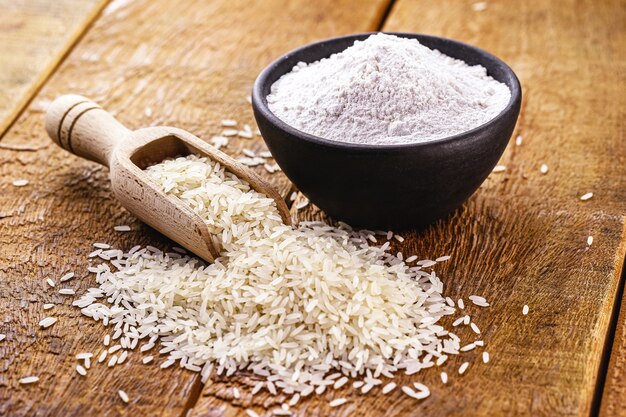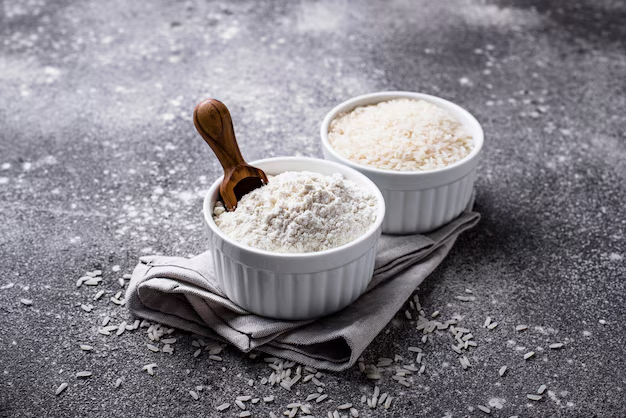Rice flour has become a staple ingredient for those seeking gluten-free alternatives in their diet. But is rice flour gluten-free? This question is crucial for individuals with gluten intolerance or celiac disease, where even small amounts of gluten can trigger severe reactions. Rice flour is derived from finely milled rice grains and is becoming a popular choice in gluten-free diets across the United States. Its versatility, texture, and nutritional benefits make it a go-to for cooking and baking. Let’s explore rice flour’s properties, types, and its role in gluten-free living.
What Is Rice Flour?
Rice flour is a fine powder made by grinding rice grains. It is widely used in many cuisines around the world, especially in Asian and Indian recipes. Its mild flavor and smooth texture make it suitable for a variety of dishes.
White Rice Flour vs. Brown Rice Flour
- White Rice Flour:
Made from polished white rice grains, this flour has a smooth, light texture. It is ideal for recipes that require a neutral flavor and a silky finish. - Brown Rice Flour:
Made from whole-grain brown rice, this flour retains the bran and germ, making it more nutritious. It has a slightly nutty flavor and a coarser texture compared to white rice flour.
Is Rice Flour Gluten Free?
Yes, it is naturally gluten-free. This is because rice, as a grain, does not contain gluten—a protein found in wheat, barley, and rye.
Why Rice Flour Is Gluten-Free
- Gluten is absent in all forms of rice, including white, brown, and wild rice.
- Rice flour is safe for individuals with celiac disease or gluten sensitivity.
Cross-Contamination Risks
While rice flour itself is gluten-free, it can sometimes be contaminated during processing or packaging. Manufacturers may process rice flour in facilities that also handle gluten-containing grains. It’s essential to check for certifications like “Certified Gluten-Free” on packaging to ensure safety.
Related to Read: Is Cornmeal Gluten Free? A Comprehensive Guide
Types of Rice Flour and Their Gluten-Free Nature
White Rice Flour
White rice flour is smooth and light. It blends well into recipes without altering the flavor. Its gluten-free nature makes it a preferred option for making sauces, desserts, and noodles.
Brown Rice Flour
Brown rice flour is packed with nutrients, including vitamins, minerals, and dietary fiber. It is also gluten-free, providing a healthy alternative for baking breads and cookies. Its coarser texture adds depth to recipes.
Benefits of Rice Flour
Rice flour offers numerous advantages for those avoiding gluten.

Versatility in Cooking and Baking
Rice flour is a multipurpose ingredient. You can use it to make bread, pancakes, muffins, and even as a thickener for soups and sauces.
Nutritional Profile
- White Rice Flour: Provides energy and is low in fat.
- Brown Rice Flour: Rich in fiber, magnesium, and B vitamins, promoting overall health.
Digestive Health
For people with gluten intolerance, rice flour is easier to digest compared to wheat flour. It helps reduce digestive discomfort and improves gut health.
Is Rice Flour Good for Gluten-Free Baking?
It is an excellent substitute for wheat flour in gluten-free baking.
Key Characteristics
- It has a light texture, which helps create fluffy cakes and soft cookies.
- When blended with other gluten-free flours, such as almond or tapioca flour, rice flour can mimic the elasticity of wheat-based doughs.
Tips for Best Results
- Use a combination of rice flour with xanthan gum or guar gum to improve binding and texture.
- Let the batter rest before baking to enhance moisture absorption.
- Experiment with different types of rice flour to achieve the desired texture and taste.
How to Use Rice Flour in Gluten-Free Cooking
Rice flour is an incredibly versatile ingredient that can be used in numerous ways to create gluten-free dishes. Whether you’re making breakfast staples, baking desserts, or thickening soups, it is an excellent option for gluten-free cooking.
Recipes Using Rice Flour
- Gluten-Free Pancakes: Rice flour creates light and fluffy pancakes with a mild flavor. Combine it with almond milk, eggs, and a touch of vanilla for a quick and tasty breakfast.
- Muffins and Breads: Its neutral taste makes rice flour a great base for muffins and breads. Mix with other gluten-free flours, such as tapioca or potato starch, for better texture.
- Cookies and Cakes: White rice flour produces soft and tender baked goods. For extra moisture, add mashed bananas or applesauce to the batter.
Thickening Soups and Sauces
Rice flour is a fantastic thickening agent. Add a small amount to soups, gravies, or sauces to achieve a smooth and creamy consistency. Stir it into a slurry with cold water before adding it to hot liquids to avoid clumps.
Combining Rice Flour with Other Flours
For the best results, combine rice flour with other gluten-free flours. This helps mimic the elasticity and texture of wheat flour. Use xanthan gum or guar gum as a binding agent to improve structure in baked goods.
Who Should Use Rice Flour?
Rice flour is suitable for a wide range of people, especially those with dietary restrictions or preferences.
Celiac Disease
Individuals with celiac disease must avoid gluten entirely. Rice flour offers a safe and nutritious alternative to wheat-based flours.
Gluten Sensitivity
For those with non-celiac gluten sensitivity, rice flour is a gentle option that is easy on the digestive system.
Health-Conscious Individuals
Even if you don’t have gluten issues, rice flour is a great addition to a healthy diet. It is low in fat, contains essential nutrients, and is naturally free of gluten.
Is Rice Flour a Good Substitute for Wheat Flour?
Rice flour serves as an excellent substitute for wheat flour, though there are some differences to consider.
Texture and Taste
- Rice flour has a lighter texture than wheat flour. This makes it perfect for recipes like cakes and cookies, where a soft and airy crumb is desired.
- It has a neutral flavor, so it won’t overpower other ingredients in your recipe.
Cooking Properties
- Rice flour lacks gluten, which affects elasticity and binding. To overcome this, it’s often combined with other flours and binding agents.
- It is less absorbent than wheat flour, so recipes may require adjustments to liquid quantities.
Effectiveness in Gluten-Free Recipes
Rice flour works beautifully in many gluten-free recipes. It excels in quick breads, pancakes, and as a coating for frying, but may need additional ingredients for elasticity in yeast-based breads.
Potential Risks or Concerns
While rice flour is safe and beneficial for most, there are a few potential concerns to be aware of.

Cross-Contamination Risks
Processing facilities can sometimes lead to cross-contamination with gluten-containing grains. Always look for “Certified Gluten-Free” labels to ensure the product is safe.
Allergies or Sensitivities
Although rare, some individuals may have allergies or sensitivities to rice. If you experience digestive issues or skin reactions after consuming rice products, consult a healthcare professional.
Gluten-Free Rice Flour Recipes
Rice flour is easy to work with and can be used to create delicious gluten-free recipes.
Pancakes
- Ingredients: 1 cup rice flour, 1 egg, 1 cup almond milk, 1 tbsp sugar, 1 tsp baking powder.
- Instructions: Mix all ingredients in a bowl. Heat a non-stick pan and pour batter to form pancakes. Cook until golden on both sides.
Bread
- Ingredients: 2 cups rice flour, 1 tsp xanthan gum, 1 tsp baking soda, 1 tbsp apple cider vinegar, 1 cup buttermilk.
- Instructions: Combine dry and wet ingredients. Pour into a greased loaf pan and bake at 350°F (175°C) for 40 minutes.
Cookies
- Ingredients: 1 ½ cups rice flour, ½ cup butter, ½ cup sugar, 1 egg, 1 tsp vanilla extract.
- Instructions: Cream butter and sugar, then mix in egg and vanilla. Add rice flour and form dough. Shape into cookies and bake at 350°F for 12-15 minutes.
Related to Read: Is Couscous Gluten Free? A Complete Guide
FAQs
Is white rice flour gluten-free?
Yes, white rice flour is naturally gluten-free. It is made from polished white rice and does not contain any gluten proteins.
Is brown rice flour gluten-free?
Absolutely. Brown rice flour is made from whole-grain brown rice and is also free of gluten. It is a nutritious option for gluten-free diets.
Can rice flour be used for celiac disease?
Yes, rice flour is safe for individuals with celiac disease. However, always check for certified gluten-free labels to avoid cross-contamination.
Is rice flour a good substitute for wheat flour?
Rice flour is a great alternative to wheat flour in many recipes. Its light texture and neutral flavor make it ideal for gluten-free baking and cooking.
What are the benefits of rice flour for gluten-free diets?
Rice flour is versatile, nutritious, and easy to digest. It is rich in fiber (especially brown rice flour) and works well in a variety of gluten-free dishes.
Conclusion
Rice flour is a naturally gluten-free, versatile, and nutritious option for those seeking alternatives to wheat flour. It caters to the needs of individuals with celiac disease, gluten sensitivity, or anyone looking to explore gluten-free cooking. With its variety of uses, from baking to thickening, it has earned its place as a staple in gluten-free kitchens. Explore its potential today and enjoy the benefits it brings to your recipes!

